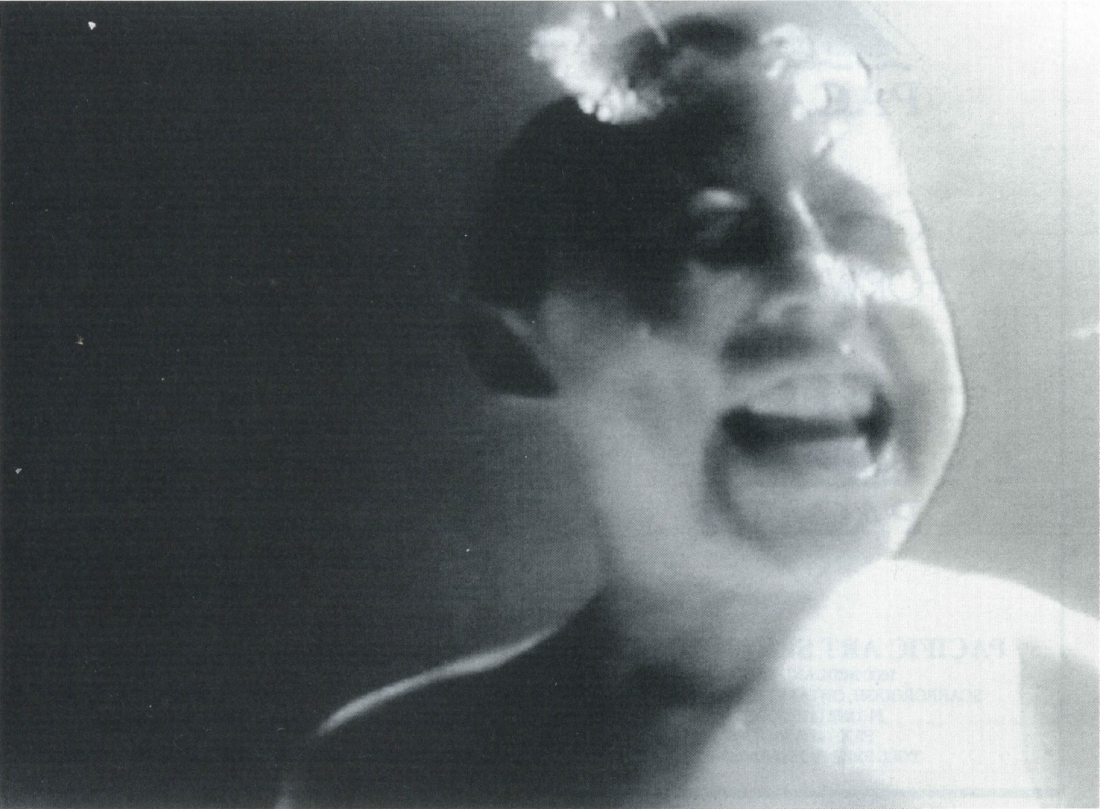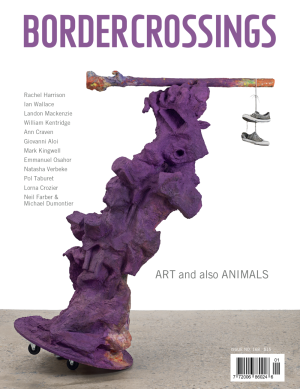Death’s Democratic Family
“Death and the Family” was a bleak and hopeful exhibition of photographic, film, video and conceptual art. “The show addressed family relationships,” wrote curator Karen Love: “how they affect the development of individual identity, and how they influence our ideas about mortality and immortality.” A persistent mood, one that constituted an important subtheme here, was the sense of disjunction and estrangement that occurs at the death of a beloved person, especially a parent. When a parent dies—a crisis that no amount of biological inevitability prepares us for emotionally—grief is made even more unbearable by the wrenching awareness of our own mortality. Perceptions are ever-after altered. “I believe that much of this work which looks at death,” said Love, “is ultimately about how we live.”
Although the show offered strong work in mediums other than video—including home movie stills and original photographs by Larry Sultan (his large chromogenic print, Mom Posing for Me, was one of the ‘most succinctly noble and pathetic images in the show) and an affecting 16 mm film projection by Wyn Geleynse, Portrait of My Father, (whose anachronistic whirs, clicks and flickerings corresponded to his father’s nervous tics and anxious shiftings)—the video components dominated. Some were brief and compelling; others lengthy, mystifying and ultimately irksome.
Paula Levine’s One Year of Mourning, 1994, a 12-minute, black and white video, takes the unapologetically banal motif of used Kleenex tissues sitting on a subtly bobbing white surface (a sheet stretched across a waterbed?), to suggest the passing of time and her own slow journey through grief after the deaths of a brother and a friend. The video transcends its imagistic constraints through silence and seering whiteness—and through the apparent evolution of the tissues. From crumpled shapelessness they come to resemble roses, camellias and cabbages, knots, balls and mountainous landscapes. Levine’s video signifies the artist’s attempt to shape meaning and form out of the everyday chaos of bereavement.
Next door, Gisele Amantea created a video installation, and sorrow come near us no more, setting the monitor on a velvet-covered altar or shrine. The velvet, which draped the shrine and hung on the wall behind it, was funereal black, flocked with a rose pattern, and augmented by rosettes in satin and velvet. Throughout the 5O-minute video, the viewer sat (or not) in a formal armchair, also upholstered in flocked black velvet, and watched as Amantea’s elderly parents spoke towards the camera. Without any particular narrative gift or personal charisma they reminisce about their parents, their siblings, their childhoods, their humble careers, their marriage, their families. Although the “performances” are static and the black and white video is crudely made, genuine poignancy attends this genealogical reconstruction. Reading the artist’s statement, we register that both Amantea’s parents have died within the past year, her father within days of this exhibition’s opening. So the personal (if not the public) necessity of recording their stories and acknowledging their lives is felt to be all the more pressing.

Bill Viola, Angel’s Gate. 1989, videotape. Photograph: Kira Perov.
Bill Viola’s colour video, Angel’s Gate, is extremely short (four minutes) and devoid of narrative. It consists, rather, of a series of images “focussing on mortality, decay and disintegration”: an old building being imploded behind a stand of palm trees; a burning candle being “extinguished”; an apple falling from a heavily laden bough; a deer being bloodily butchered. Also montaged here are images of boredom, depression and confinement: a falcon struggling against its chain; a bearded man lying on a bed and sighing. Still, symbols of new life occur: a wedding party, a baby being born, a young boy holding his breath under water, then bursting into laughter and a cloud of bubbles.
Viola has eloquently described his video as “a series of openings or momentary glimpses into nature’s essential gestures which, like thoughts, are destined to fade and themselves disintegrate in obscurity and oblivion.” At the end of the video, the camera approaches a locked, metal gate through an underground passageway and is “liberated” by “a kind of universal light” that floods the screen. While this ending takes some of its meaning from cliched reports of near-death experiences, it is nonetheless powerful. So is the brevity of Viola’s work.
Toby MacLennan’s installation, How Will I Know I’m Here, consisted of an immense video screen standing behind an equally large pool of inky, reflective water. The video itself is 45 minutes long and a-tumble with inexplicable, surreal images: naked people crawling down a flight of stairs and onto a dark lawn; water gushing out of human ears, faces, chests; two fat, naked, elderly people running through woods and glades, one of them with a stuffed deer strapped to his back; a group of women, dressed as nuns, leaping off a diving platform; birds, skulls, seahorses and plastic animals emerging (gaggingly) from people’s mouths; a naked young woman wallowing in mud; a young man caressing a stuffed deer; a live deer walking through an open door and tentatively exploring a sunlit room; a man made up like a Stone Age shaman with white and black painted face and antlers tied to his head, standing neck-deep in water or running and leaping amidst a group of dark-suited people. (The repeated deer motif evokes—not too subtly—notions of soul or spirit.)
The narrative which accompanies these dream-like and disjointed images seems to have a separate existence and offers little by way of explanation. It ranges through unconnected dreams and allegories before eventually recounting the death, by cancer, of MacLennan’s mother. “I was obsessed with trying to chart my way through my mother’s dying,” Maclennan has said. “Suddenly there was no discrepancy, no wall between an unconscious life and conscious life, no difference between this world and the next.” Death being “the greatest mystery of our lives,” Maclennan has chosen to make her work mysterious and uncomfortably long. I was reminded of a grimly existential T-shirt I’d recently seen on a skate-boarding 12 year old. “It’s not that life is so short,” the T-shirt read, “it’s just that you’re dead for such a LONG time.” ♦
“Death and the Family,” was on exhibition at Presentation House Gallery in North Vancouver from April 22 to June 11, 1995.
Robin Laurence is Border Crossings’s Contributing Editor in Vancouver.

